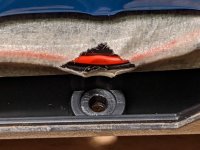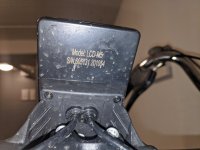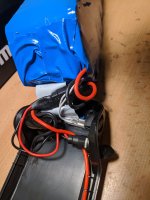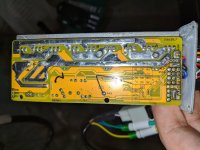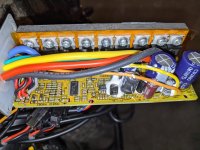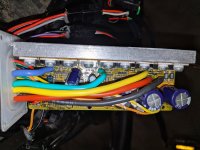smitel said:
The bike is sold as being 1000 watt, but I'm seeing just 8.0 on the display.
I'm curious to see if I can find if the controller and/or hub truely 'are' 1000 watt or if it's just upmarked.
Also just random curiousity.
That's always a good reason.

As for the true wattages...a "1000w" hubmotor (continuous ability) is likely to be a DD hubmotor. If your bike is this one
https://www.amazon.com/milo-MX02S-Electric-Bicycle-Mountain-Hydraulic/dp/B0893QMF6F
then it's a smaller geared hubmotor that from what I can see in that particular ad might really be capable of 350-500w continous, and *maybe* 1000w short peaks. The 1000w geared hubmotors I'm familiar with are ones like the MAC, BMC, GMAC, and sometimes the Ezee is listed as such. I have a "1000w" by Fusin (no longer around) that is probably less capable than the Ezee in reality, based on motor internals, but is almost the same size externally.
For short peaks, a geared hubmotor with sufficient thermal mass might handle two or more times what it can handle continously, but without sufficient cooling or motor mass / etc., if you keep putting those peaks into it or push it continuously at that, it'll overheat because it cant' get rid of the heat fast enough. More copper/stator/magnet mass means more continous power with less heat created. (non hubmotors can spin much faster and thus be much smaller for the same power...if they are cooled well enough). Geared hubmotors can't get rid of all that heat very well because there are three layers to them, with two big airgaps inside blocking heat transfer.
DD hubmotors can do bigger peaks relative ot the continous power, and can also do longer peaks and often some amount higher than continuous rating if they are kept above a certain percentage of their no-load speed all the time, and/ore have sufficient cooling, partly because they have more thermal mass, partly because they have more stator/copper/magnet mass, partly because they only have one airgap for heat to cross.
Controllers...generally I wouldn't be putting a 1000w controller inside a box with no airflow, and also generally that size controller will be 12-15FETs, where a 500w or less controller mgith only be 6 or 9. Your pics seem to show a controller about the size of the palm of my hand, which is likely a 6FET.
FWIW, I found this kit:
https://endless-sphere.com/forums/viewtopic.php?f=2&t=103162
at goodwill a while back, and while I don't know what the bike it came from was advertised as, the stuff I got with it that appears to all be from that bike is about a 500w max setup.
Oh, and a quick look on this model name finds this page
https://electricbikereview.com/forums/threads/sheng-milo-1000w-fat-ebike.35460/
which I only skimmed the first page and a half of, which doesn't sound good.

When the battery LVC kicks in, the battery will disconnect the output until it's recharged?
Depends on the BMS. Many only shut off until the load goes away, then come back on...this allows the user to beat the crap out of the battery until it is really really dead.

Maybe more fun for the user, not so great for the battery....
I recently went out with half a battery to see how my bike behaves when out of juice.
In my case, the display starts blinking and shortly after this the entire bike shuts off and doesn't come back.
The blinking display is probably the controller LVC. If the whole display shuts off, that's probably the battery LVC.
In contrast, my friends RadRhino goes into some sort of limp-home-mode. It doesn't turn off, but the power is greatly reduced.
Is this the controller reaching some low-voltage threshold and reducing the power to prevent the battery LVC from kicking in?
Very likely. If the RadRhino is from Radpower bikes, then it's probably this. Someone else I helped out locally here had a Rad bike with a similar protection, which was not user-alterable in that system. (partly this is so the company doesnt' have to deal with hammered battery warranty claims and other such troulbeshooting headaches).
If so, there's an undervoltage parameter in my LCD that might have the same effect. It was set to 39v from the factory, but maybe that's too low.
39v is reasonable for a 13s 48v pack, as that is still 3v / cell, which you might see under load when the battery is low. But if you don't mind a bit less range in trade for a longer-living battery, upping that as much as you can may help that (it will just shut your ride off sooner).
smitel said:
The display goes from '000.0' to '008.0' in '001.0' increments.
Do you mean the setting menu, or do you mean the active live display while riding? If the former, there's no guarantee that the number actually means amps directly, but may represent divisions of the maximum amps the controller is capable of. However, if it really is a 6FET (or even 9) controller, 8A is a reasonable maximum limit for it.
With regards to the current limit, in many specs I see talk of 'maximum current' vs 'nominal current'. Often the maximum' is roughly double of the nominal. This makes me think the nominal of mine is probably half the 18A.
That's possible. Ratings on ebike stuff is unfortunately largely a matter of marketing. What things are actually capable of continously working at without affecting lifespan or risk of failure (and sometimes what they can even do at all) doesn't always (often?) have much to do with what the sellers advertise them as. Even manufacturers are not unlikely to label things as far more capable than they really are. It's all about making money, and when this stuff goes outside China for sale, those sellers and manufacturers are unlikely to have to deal with the problems this creates, so they have no incentive to do the right thing instead.
Many sellers outside China don't care much either, even if they have a clue (which most don't) about what the stuff they sell can *actually* do vs what it says it can do. Some even make the problem worse, by exaggerating the already-exaggerated claims.

There are a *few* knowledgable and simultaneously reputable places...but not many. The only good one I have had any direct experience with is Grin Tech, http://ebikes.ca , though Radpower hasn't caused any grief via misinformation to the couple of locals I've helped out.
That's a shame. In other topics, like motherboards, USB sticks, etc. it's not uncommon for manufacturing tools and documentation to leak out.
Yeah, although it doesn't always make things better, like in this case. I think that this leakage of documentation may have resulted in the plethora of fake-capacity USB sticks out there (and similar stuff might have done the various fake-capacity memory cards).
But we cant' fault the documenters for the assholes that take advantage of others.

User-documentation of ebike/etc stuff is one reason this forum exists, though, so feel free to post anything you do find about anything you run across like that for EV stuff.

Maybe in the ebike world not a lot of computer-work is done in the factory and the guys doing the assembly don't have access to more bits than we do with the P-parameters?
I doubt the assemblers do more than physically slap the stuff together as fast as they can possibly manage without killing themselves, and probably for as long as they can do it without collapsing from hunger and fatigue, for "wages" that many (hopefully but not realistically all) of us would consider criminal slave labor.
It is likely that the programming is generally done during the original board-manufacturing stage just after the point they have the MCU and all the other SMD bits on there (probably a single process), even before they stick on the FETs and other thru hole parts, as almost no controller I've ever seen ever has (or had ever had) anything soldered to the programming port pads on the board. That implies a process that just presses a programming "cable" or fixture to the board long and hard enough to verify and setup the MCU with the specific firmware and settings for that run of controllers. Even the people doing that work probably know nothing about the stuff going in there, and most likely only know enough about the process to ensure it is occuring. (assuming it is not completely automated, which at this stage of manufacturing is easily possible).
I seriously doubt any of these things get programmed or setup later in the process, after being assembled into housings with wires, and especially not after they're on OEM bikes. It would just take too much time and training and labor.


